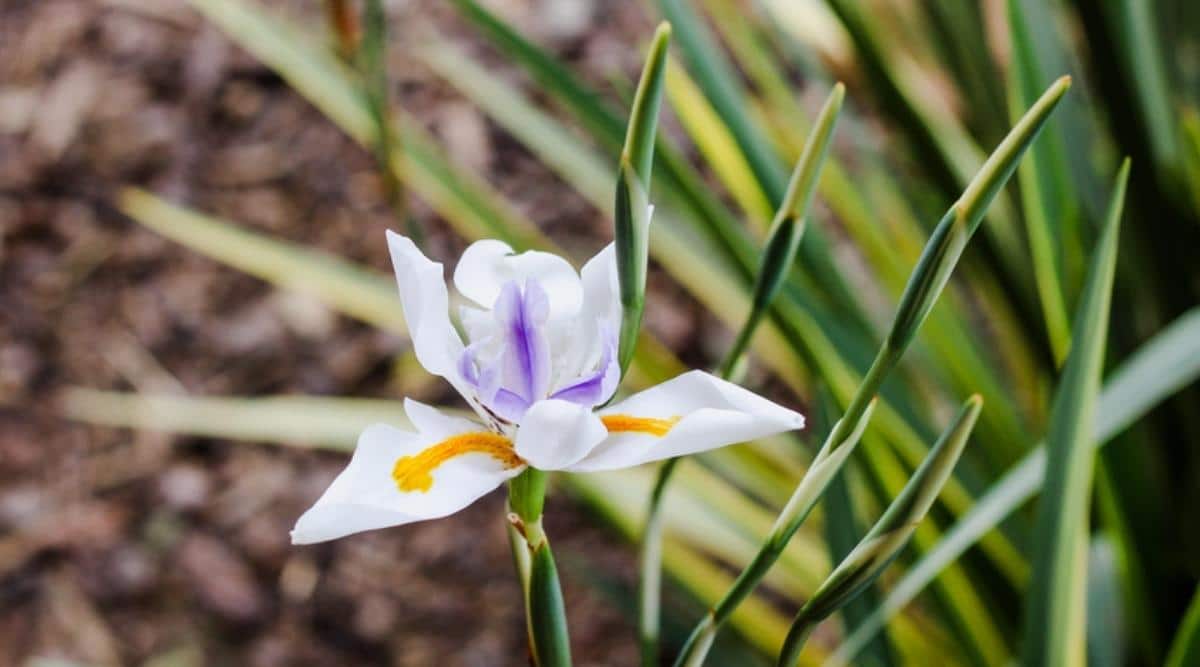journalofserviceclimatology.org – The Fairy Iris (Dietes bicolor) is a captivating flower known for its delicate, striking blooms and graceful appearance. Native to South Africa, this iris species has gained popularity in gardens around the world due to its beauty, resilience, and ease of care. Its unique, two-tone flowers, combined with its ability to thrive in a variety of climates, make the Fairy Iris a beloved choice for ornamental gardens and landscapes.
What Makes the Fairy Iris Special?
The Fairy Iris is a member of the Iridaceae family, distinguished by its elegant flowers that feature a combination of white, yellow, and purple hues. Each flower has three outer petals, which are typically white with a splash of yellow or purple near the base, and three inner petals that are smaller, often with intricate markings. These blooms appear in clusters atop tall, graceful stems, adding a touch of sophistication and color to any garden.
Unlike many other iris species, the Fairy Iris is known for its ability to bloom repeatedly throughout the year, especially in mild climates. This extended blooming period, combined with the plant’s attractive foliage, makes it a standout choice for gardeners looking to create vibrant, long-lasting displays.
Key Features of the Fairy Iris Flower
- Striking Flowers: The most distinctive feature of the Fairy Iris is its exquisite flowers, which are white with delicate yellow and purple markings. The blooms are typically about 2 to 3 inches across and bloom in clusters, creating a dramatic visual impact.
- Evergreen Foliage: The Fairy Iris has long, sword-like leaves that form dense clumps. These evergreen leaves maintain their lush green appearance year-round, providing structure and texture to the garden, even when the plant is not in bloom.
- Repeated Blooming: Unlike many iris species that bloom only once a year, the Fairy Iris produces flowers multiple times throughout the year, especially in warmer climates. This prolonged blooming period ensures that gardens stay colorful and lively for months.
- Hardiness: The Fairy Iris is a hardy plant that can thrive in various soil types and climates. It is particularly well-suited to warm regions but can also tolerate some cold temperatures in more temperate areas.
Symbolism of the Fairy Iris Flower
The Fairy Iris is often seen as a symbol of purity, elegance, and grace. Its delicate, intricate flowers evoke a sense of tranquility and refinement, making it a perfect addition to any garden designed to promote peace and beauty. The iris family, in general, is associated with wisdom and hope, and the Fairy Iris is no exception. Its graceful blooms can be seen as a representation of resilience and endurance, as it flourishes year-round in challenging conditions.
Growing the Fairy Iris Flower
Fairy Iris is relatively easy to grow and care for, making it a great choice for both novice and experienced gardeners. Here are some tips for cultivating this beautiful flower:
- Sunlight: The Fairy Iris thrives in full sun to partial shade. For the best flowering, it should be planted in a location where it can receive at least 6 hours of sunlight per day.
- Soil: This plant prefers well-draining soil, although it is adaptable to various soil types. A sandy or loamy soil mixture is ideal. It’s important to ensure that the soil does not become waterlogged, as this can lead to root rot.
- Watering: While the Fairy Iris is relatively drought-tolerant once established, it will benefit from regular watering during dry spells. Be careful not to over-water, as it prefers slightly dry conditions between waterings.
- Pruning: To encourage continuous blooming and maintain a tidy appearance, it is recommended to remove dead or damaged flowers and foliage regularly. This will also help the plant focus its energy on producing new blooms.
Uses of the Fairy Iris Flower
- Ornamental Landscaping: The Fairy Iris is a stunning addition to any ornamental garden, especially in mixed borders, rock gardens, or as an accent plant. Its graceful blooms and evergreen foliage create a lovely visual contrast with other flowers and plants.
- Containers and Pots: Due to its compact size, the Fairy Iris is well-suited for container gardening. It can be planted in pots or hanging baskets to add a touch of elegance to patios, balconies, or entranceways.
- Pollinator-Friendly Gardens: The Fairy Iris attracts pollinators such as bees and butterflies, making it an excellent choice for wildlife gardens. Its vibrant blooms provide nectar for these essential garden creatures.
Conclusion
The Fairy Iris is a truly enchanting flower, known for its elegance, resilience, and repeated blooming cycles. Whether grown in the garden, in containers, or as part of a larger landscape design, the Fairy Iris adds a touch of grace and beauty to any setting. Its striking, delicate flowers and evergreen foliage make it a year-round source of interest, ensuring that it remains a favorite choice among gardeners for years to come.
